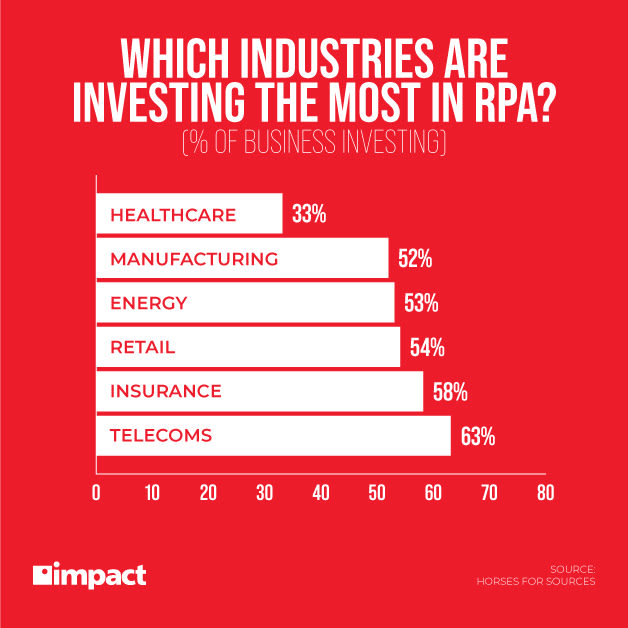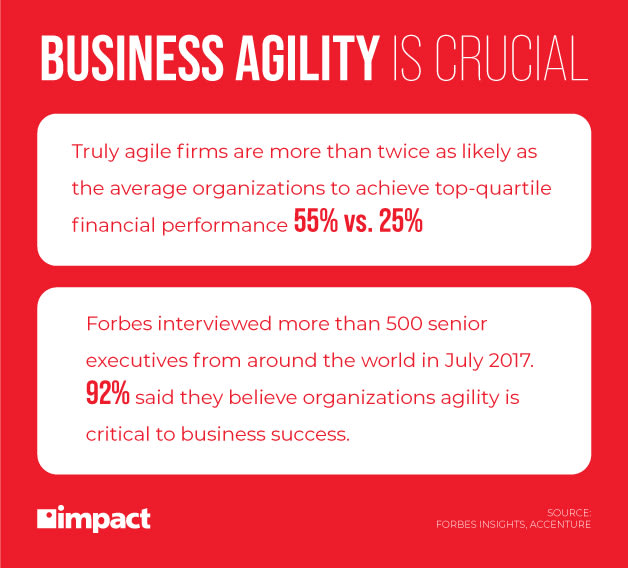Business process automation in retail has been growing in popularity, not least because of the pressures that modern retailers frequently find themselves under—rising labor costs; difficulty managing e-commerce supply chains; and increasing expectations from customers in terms of their experience with vendors.
By 2025, retailers are expected to have 71% of tasks automated with the intent of shifting their workforce toward more customer-facing or operational roles.
Let's take a look at six use cases for retail automation platforms in retail—how are commercial businesses implementing automation? What can automation do for you and what technology should you be looking to implement to achieve it?
Opportunities for innovation are all around you, especially in retail where the speed and ease of processes can make a massive difference to customers. Learn how to identify high-value spots for innovation (like automation) in our free on-demand webinar, How to Identify High-Value Opportunities for Innovation.
What is a Retail Workflow?
In retail, many different processes can use automation and workflows to simplify and streamline. Inventory management, purchasing, billing, customer service, and more can all utilize retail automation platforms to improve the effectiveness and speed of a process.
To build a workflow, retailers use an automation platform to create a series of automation that trigger specific actions and move the process forward. For example, if a customer sends in a service ticket, automation can decide the next step: fulfill a request, follow up with an email, or send it to a representative.
This removes unnecessary human involvement (sifting through emails, responding manually, etc.) meaning those people can spend less time on these repetitive, simple tasks and focus on more important work.
Similar functions can be built for all the types of processes discussed above and more. The real benefit of retail automation and retail workflows is that it is limited only by creativity, time, and expertise.
Examples of How Retail Automation Directly Helps Stores
1. Streamline the Returns Process
32% of consumers in America say they only purchase from retailers who offer free returns and they expect the process to be simple. People buy products sight unseen. 41% of customers have even made a habit of over-buying products with the intent of returning some.
They take this risk because a smooth and quick returns process is now the expectation.
That’s why returns processing is now such a massive deal for retailers. Not only has it become a requirement to do business online, but it’s also a way to stand out by providing a better customer experience.
Processing returns manually can be an extremely cumbersome and time-consuming task that requires multiple people and, depending on the volume of returns, cost you a lot of money.
With automation, every return can be completed quickly with little or even no input from human workers—from database entry to reversing the customer billing. Not only does this create a better experience for customers, but it also frees you to redirect your workforce to more high-impact projects or tasks.
2. Retail Workflows
Retail business process flows for stores are an important aspect in the functioning of a modern business.
Retailers rely on human activity as much as any industry out there, and human interaction with customers is crucial.
So, when staff is getting bogged down with manual, back-office tasks, it might be worth asking whether some of those processes could be streamlined.
Automation can be introduced into virtually any HR or management process, whether it’s automating work schedules, payroll, employee performance, or invoices—you name it.
Common automation use cases for retail workflows are automated reports for stock levels, inventory losses, buying patterns of repeat customers, automated reminders to staff who haven’t submitted timesheets on time, alert for short shelf-life products that are nearing expiration.
Hundreds of these day-to-day processes in your workflow can be automated, saving you and your staff time.
Introducing automation into your retail business process flows drastically reduces the time spent performing traditional manual jobs, while at the same time freeing up staff to focus on other tasks that need them.
Related Post: Digital Document Workflow Explained
3. Customer Support
It should come as little surprise that in today’s retail environment, customer satisfaction is more important than ever.
Customers want to feel looked after and don’t take kindly to businesses that don’t demonstrate an understanding of how to deal with them in a positive way.
62% of consumers cite brand trust as an important factor in their purchasing decisions
Consider how brands are already using automation—regularly updating customers on their order in real-time; offering 24/7 support on your site with a bot; getting priorities through to someone quickly when they have a complaint.
These are all things that companies are already achieving through their use of business process automation in retail.
This is done by tracking customers through their journeys from start to finish—by understanding customers across all of their digital touchpoints in the buyer’s journey, retailers can more effectively cater to them in a way that provides more satisfaction and a better customer experience.
A typical example of this would be to have a structure for a specific email or social outreach campaigns to customers depending on where they are in the sales funnel, allowing for a more personal feel to your communication—a crucial aspect of retail today.
Over three-quarters (76%) of customers expect companies to have an understanding of what they want and to tailor their service accordingly.
4. Store Planning
Retailers, of course, have to plan out their stores according to what will serve their customers best.
But what if they’re flying blind and basing product placement on guesswork?
Thanks to automation, that no longer needs to be the case. Retailers can implement automation to determine what products customers are drawn to and how store layout can positively benefit customer experience and sales.
Some organizations have implemented sensors, which detect and report which aisles customers are spending the most time in and which products they look at the most.
With the data reported, retailers can use this information to determine the absolute best store layout for their customers.
It doesn’t necessarily have to be this advanced, either—most retailers are unlikely to want to install sensors in their shops at the drop of a hat.
Instead, analytics platforms can be used to assess on an extremely granular level. For example, on a store-to-store basis, buyer trends can be broken down to the product level, as well as other analytics on behavior, demography, and locale.
All of this data can be used to better plan stores to ensure that the most sought-after products by customers are given preference in a particular store, at a particular time to maximize revenue.
5. Inventory Management
Traditional methods of inventory management typically involve a human worker manually accessing weekly spreadsheets to determine how to manage it.
Retail store automation can help in a number of ways:
More visibility: When you stick to using spreadsheets, you have the ability to see inventory data within your business in real-time. When you automate your inventory system with tracking, you can set up automated replenishment of stock, automated delivery, as well as syncing all of your sales channels into one system.
Decrease human error: One of the biggest benefits of automation will always be how useful it is in terms of reducing errors by staff. With business process automation in inventory management, this means reducing the number of people performing manual tasks with regard to inventory, and your business no longer making mistakes as a result.
6. Behavior Analysis
As we briefly mentioned above, behavioral analysis can be used by retailers to better understand their customers and accommodate them.
Retail businesses have to be quick to respond in their market and able to correctly access trends and take advantage of them.
With automation, businesses are able to expedite a lot of processes that have traditionally been expensive jobs.
79% of retail and consumer products companies expect to be using intelligent automation for customer intelligence by 2021
In marketing, for example, it helps organizations know what their customers are interested in so that they can then promote products that will resonate.
But data gathering and analysis are expensive; unless you implement a system that does it for you.
With automation, you can access each campaign and take insights from the data you receive, allowing you to modify your future campaigns in order to appeal better to customers based on how they’ve previously interacted with your products, services, and campaigns.
Bottom Line
Business process automation services and solutions in retail have a prominent role to play as we enter the new decade. Automation can be used for a variety of purposes, and automation technologies and solutions are as affordable now as they’ve ever been in the past.
Whether it’s improving the customer experience, automating back-office processes, your inventory management, or determining what your customers like best through their behavior, there’s a place for BPA in every retail business, and retail store automation should be strongly considered to get an advantage over competitors.
Automation in retail can reinvent how your business operates, giving your teams more hours back for high-value projects and providing a smoother and faster customer experience. Learn how you can more easily identify areas ripe for automation with our free on-demand webinar, How to Identify High-Value Opportunities for Innovation.


